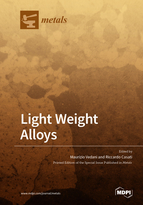Light Weight Alloys: Processing, Properties and Their Applications
A special issue of Metals (ISSN 2075-4701). This special issue belongs to the section "Metal Casting, Forming and Heat Treatment".
Deadline for manuscript submissions: closed (28 February 2018) | Viewed by 82890
Special Issue Editors
Interests: material science; metallurgy; additive manufacturing
Special Issues, Collections and Topics in MDPI journals
Interests: material science; metallurgy; additive manufacturing
Special Issues, Collections and Topics in MDPI journals
Special Issue Information
Dear Colleagues,
Light metallic alloys are continuously gaining growing interest for a wide number of applications owing to energy saving and environmental sustainability issues, as well as good processability for the easy shaping of parts and biocompatibility for medical applications (especially for Ti and Mg).
The aim of this Special Issue is to highlight recent innovations introduced in the fields of light alloys considering the perspectives of new materials and related processing routes and of new fields of applications and design strategies in these sectors.
Prof. Maurizio Vedani
Dr. Riccardo Casati
Guest Editors
Manuscript Submission Information
Manuscripts should be submitted online at www.mdpi.com by registering and logging in to this website. Once you are registered, click here to go to the submission form. Manuscripts can be submitted until the deadline. All submissions that pass pre-check are peer-reviewed. Accepted papers will be published continuously in the journal (as soon as accepted) and will be listed together on the special issue website. Research articles, review articles as well as short communications are invited. For planned papers, a title and short abstract (about 100 words) can be sent to the Editorial Office for announcement on this website.
Submitted manuscripts should not have been published previously, nor be under consideration for publication elsewhere (except conference proceedings papers). All manuscripts are thoroughly refereed through a single-blind peer-review process. A guide for authors and other relevant information for submission of manuscripts is available on the Instructions for Authors page. Metals is an international peer-reviewed open access monthly journal published by MDPI.
Please visit the Instructions for Authors page before submitting a manuscript. The Article Processing Charge (APC) for publication in this open access journal is 2600 CHF (Swiss Francs). Submitted papers should be well formatted and use good English. Authors may use MDPI's English editing service prior to publication or during author revisions.
Keywords
- Aluminum alloys
- Titanium alloys
- Magnesium alloys
- Innovative Processing routes
- Advanced design and applications







